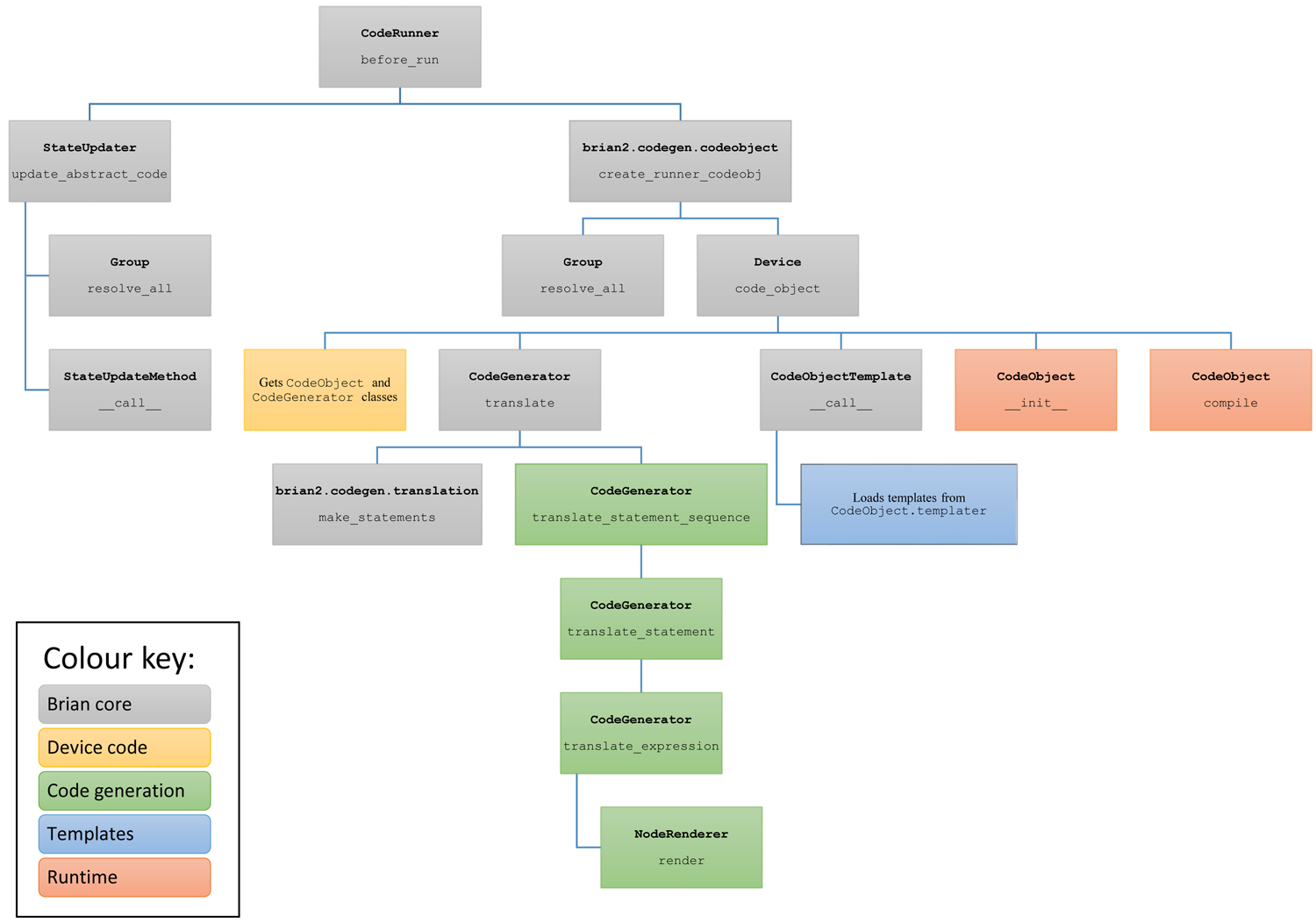Code generation¶
The generation of a code snippet is done by a CodeGenerator class.
The templates are stored in the CodeObject.templater attribute, which is
typically implemented as a subdirectory of templates. The compilation and
running of code is done by a CodeObject. See the sections below for each
of these.
Code path¶
The following gives an outline of the key steps that happen for the code
generation associated to a NeuronGroup StateUpdater. The items in grey
are Brian core functions and methods and do not need to be implemented to
create a new code generation target or device. The parts in yellow are
used when creating a new device. The parts in green relate to generating
code snippets from abstract code blocks. The parts in blue relate to creating
new templates which these snippets are inserted into. The parts in red
relate to creating new runtime behaviour (compiling and running generated
code).

In brief, what happens can be summarised as follows. Network.run() will call
BrianObject.before_run() on each of the objects in the network. Objects such
as StateUpdater, which is a subclass of CodeRunner use this spot to
generate and compile their code. The process for doing this is to first
create the abstract code block, done in the StateUpdater.update_abstract_code
method. Then, a CodeObject is created with this code block. In doing so,
Brian will call out to the currently active Device to get the CodeObject
and CodeGenerator classes associated to the device, and this hierarchy of
calls gives several hooks which can be changed to implement new targets.
Code generation¶
To implement a new language, or variant of an existing language, derive a class
from CodeGenerator. Good examples to look at are the NumpyCodeGenerator,
CPPCodeGenerator and CythonCodeGenerator classes in the
brian2.codegen.generators package. Each CodeGenerator has a class_name
attribute which is a string used by the user to refer to this code generator
(for example, when defining function implementations).
The derived CodeGenerator class should implement the methods marked as
NotImplemented in the base CodeGenerator class. CodeGenerator also has
several handy utility methods to make it easier to write these, see the
existing examples to get an idea of how these work.
Syntax translation¶
One aspect of writing a new language is that sometimes you need to translate
from Python syntax into the syntax of another language. You are free to
do this however you like, but we recommend using a NodeRenderer class
which allows you to iterate over the abstract syntax tree of an expression.
See examples in brian2.parsing.rendering.
Templates¶
In addition to snippet generation, you need to create templates for the
new language. See the templates directories in brian2.codegen.runtime.*
for examples of these. They are written in the Jinja2 templating system. The
location of these templates is set as the CodeObject.templater attribute.
Examples such as CPPCodeObject show how this is done.
Code objects¶
To allow the final code block to be compiled and run, derive a class from
CodeObject. This class should implement the placeholder methods defined in
the base class. The class should also have attributes templater (which
should be a Templater object pointing to the directory where the templates
are stored)
generator_class (which should be the CodeGenerator class), and
class_name (which should be a string the user can use to refer to this
code generation target.
Default functions¶
You will typically want to implement the default functions such as the
trigonometric, exponential and rand functions. We usually put these
implementations either in the same module as the CodeGenerator class or
the CodeObject class depending on whether they are language-specific or
runtime target specific. See those modules for examples of implementing
these functions.
Code guide¶
brian2.codegen: everything related to code generationbrian2.codegen.generators: snippet generation, including theCodeGeneratorclasses and default function implementations.brian2.codegen.runtime: templates, compilation and running of code, includingCodeObjectand default function implementations.brian2.core.functions,brian2.core.variables: these define the values that variable names can have.brian2.parsing: tools for parsing expressions, etc.brian2.parsing.rendering: AST tools for rendering expressions in Python into different languages.brian2.utils: various tools for string manipulation, file management, etc.
Additional information¶
For some additional (older, but still accurate) notes on code generation: